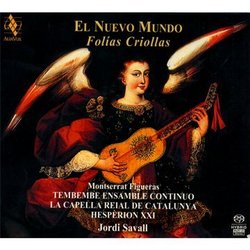Truly magnificent, if not always 'Criollas'...
Maddy Evil | London, UK | 05/18/2010
(5 out of 5 stars)
"Given the surge in interest which Spanish New World baroque music has enjoyed in recent years, it seemed almost inevitable that Jordi Savall and his excellent team of musicians would return to this fascinating repertoire at some point. As always with recordings produced on his own 'Alia Vox' label, the production is sumptuous, both in terms of the recorded sound and the presentation, which includes a lavish booklet of nearly 100 pages, complete with full texts/translations and numerous illustrations.
In many respects, 'El Nuevo Mundo: Folías Criollas' forms a direct link with Savall's 2004 release entitled Villancicos y Danzas Criollas, although there are also some important differences. Firstly, whilst repertory preserved in Spanish colonial cathedral sources is still significant here (e.g. the Gaspar Fernandes Cancionero [Oaxaca Cathedral, RBMSA 196]), much greater emphasis is placed on indigenous/Creole music, both in terms of what still forms part of today's Latin American oral tradition (particularly 'son jarocho') as well as that which is preserved in sources like the Codex Martínez Compañón (an invaluable 9-volume work compiled by the bishop of Trujillo in c.1783-5 which, alongside recording the ceremonies and customs of N. Peru, contains 20 songs/dances and 38 watercolour illustrations relating to music). Furthermore, as on many of his recent recordings, Savall has collaborated with several guest performers for this project, notably the group Tembembe Ensamble Continuo (who also featured on Los Otros's recording La Hacha), alongside musicians from Argentina, Columbia and Venezuela. The combination of all these factors results in a compelling and highly evocative recording, irrespective of any concerns one might voice about the juxtaposition of the two traditions within the same track - one which is very much alive today, the other taken from historical sources, frequently for solo guitar (like Santiago de Murcia [Saldívar Codex no.4, 1732] and Gaspar Sanz [Instrucción de música sobre la guitarra española, 1674], etc.).
Technically speaking, however, the title 'El Nuevo Mundo: Folias Criollas' is a bit misleading. In fact, the programme includes several pieces which not only reflect European culture but even originated there. Such is the case with the seguidillas 'De tu vista celoso' (track 9), which comes from the Cancionero Musical de Sablonara (D-Mbs E 200): the source is of Spanish provenance - it was compiled in c.1625 by Claudio de la Sablonara, the court copyist to Philip III of Spain (r.1598-1621), at the request of Wolfgang Wilhelm, Count of Neoburg and Duke of Bavaria (r.1614-53) - and the 'seguidillas' dance itself originated in Spain before becoming 'creolised' in 18th century Latin America. Similarly, the two 'tonos humanos' (tracks 7 and 14) are inextricably connected with the Spanish court - Juan Hidalgo's 'Trompicávalas Amor', for example, comes from the finale of the zarzuela 'Los celos hacen estrellas' which was staged there in 1672. Perhaps the most curious addition to the programme in this respect is the improvisation based on the distinctly Italianate 'Gagliarda [n.b. not 'Gallarda'] Napolitana' (track 1), which comes from Antonio Valente's 'Intavolatura di cimbalo' (1576). Although this has been justified on the basis of its bass line, apparently identical to the 'jarabe loco' peasant song which follows it (from Velez, in the central Andean region of Columbia), this supposed link may, in fact, be no more significant than the coincidental melodic similarity of the 15th-century villancico 'Tres morillas m'enamoran' (no.24 in the Cancionero Musical de Palacio [E-Mp II-1335]) and the opening of the second movement ('Andante con moto') of Mendelssohn's Symphony No. 4 in A major Op. 90 ("Italian"). Incidentally, the interpretation of the Valente 'Gagliarda' also seems most unlikely, historically speaking, and some of the other tracks seem problematic from this perspective (e.g. the use of viols in the Codex Martínez Compañón pieces and percussion in the 'tonos humanos', etc.).
In spite of these minor points, however, this really is a magnificent release, even by Savall's high standards. As a side point, if you are new to this music, there are several other excellent recordings of this repertoire which would be well worth investigating alongside this one -
1. Any of the recent recordings by Florilegium (from their 'Bolivian Baroque' series), featuring the Arakaendar Bolivia Choir, made up entirely of Bolivian singers - Bolivian Baroque Vol. 2 [Hybrid SACD] is particularly good, in my view.
2. Two CDs by Ensemble Elyma - Fiesta Criolla (Bonus Dvd) and Juan de Araujo: L'Or et l'Argent du Haut-Pérou. (Sadly, recordings by this group are becoming increasingly like gold dust, but they are certainly worth purchasing if you get a chance...!)
3. Música en Tiempos de Velázquez by Ensemble La Romanesca (with Marta Almajano, soprano), a fine recording of Spanish music from the reigns of Philip III to Charles II, which includes numerous 'tonos humanos'.
4. Lastly, for a very different take on pieces from the Codex Martínez Compañón, but again interpreted within the context of Latin American oral traditions, the recording Son de los Diablos (Afro-Latin Tonadas from Peru) by Sapukái is incredibly infectious: it features 5 songs from this manuscript, set alongside other Afro-Hispanic tonadas from the Peruvian oral tradition, performed on numerous indigenous instruments (such as the zampoña zanca, quena, tiple and cajón, etc.)."


 Track Listings (20) - Disc #1
Track Listings (20) - Disc #1